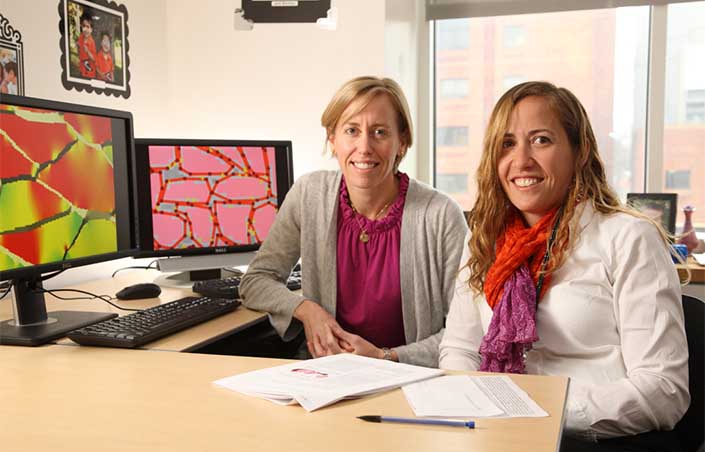As any engineer will tell you, how you frame a problem determines how you solve it. Both Silvia Blemker and Shayn Peirce-Cottler, associate professors in the University of Virginia’s Department of Biomedical Engineering, study muscle tissue, and they both have developed highly sophisticated computer models that trace the ways muscles adapt to changing circumstances.
Because their approaches are distinct, the insights they drew from their research were distinct as well.
Blemker looks at muscles from a biomechanical perspective. She sees muscles as a series of structures and microstructures, and the model she and former graduate student Bahar Sharafi created shed light on the way the mechanical properties of these structures determine the way the muscle as a whole functions. If you’re interested in finding out why some people are more prone to pulling their hamstrings than others, this is a good place to start.
Shayn Peirce-Cottler takes a different approach. She looks at the muscle tissue in a blood vessel – tissue that enables blood vessels to expand and contract – and she’s interested in the biochemical signals that determine how this tissue responds to exercise and to disease. If you would like to know how diabetes affects blood vessel walls, the biochemistry can be revealing.
Both Blemker and Peirce-Cottler had been aware that these two pathways intersect – that in the natural world, biomechanical responses quite often influence the biochemical ones, and vice versa – but each lacked the knowledge to pursue the connection. In addition, they each had compelling research projects in their own areas of expertise that required their attention.
Their mutual interest in Sharafi’s work brought the two faculty members together – and raised the possibility of pursuing a project that would take the natural integration of biochemical and biomechanical factors as its inspiration.
“The more we talked, the more we realized that if we wanted to study those intersecting behaviors, we were logical collaborators,” Peirce-Cottler said.
For their joint project, they chose to model the way a muscle responds to tendon transfer surgery, a common reconstructive procedure. In these operations, a surgeon moves the tendon at the end of a muscle from its normal attachment point on a bone and anchors it elsewhere, restoring lost function.
“Oftentimes the outcome is limited by fibrosis or some maladaptation of the muscle after surgery,” Blemker said. “It’s difficult for surgeons to gauge how to ensure that muscle stay as strong as possible.”
Equally important, this type of operation provides an ideal situation to explore the intersection of biomechanical and biochemical factors. “By moving the muscle, you change its mechanical function,” Peirce-Cottler said. “At the same time, you activate biochemical pathways and trigger a set of immune responses.”
They received a $395,000 grant from the National Science Foundation to pursue this project and are working with graduate student Kyle Martin, who they are co-advising.
In the process of developing a multidimensional understanding of the muscle response, Peirce-Cottler and Blemker have discovered why the collaboration of the sort they’re pursuing is so unusual. For one thing, the modeling strategies they use are very different. Peirce-Cottler uses agent-based models; Blemker uses finite-element models.
“When it comes to combining models, the easy approach is simply to apply raw computational power,” Peirce-Cottler said. “But finding a way for them to talk to each other in a meaningful way is a conceptual challenge, and that takes creativity.”
With each success in combining their models, Blemker and Peirce-Cottler are finding new research questions to answer. They are taking a fresh look at muscular dystrophy, finding that the tools they are using to model a muscle’s physiological and pathophysiological response after surgery can be applied to understanding how the diaphragm is weakened by the disease.
“Our work together is enabling us to pursue questions that we previously had no ability to explore,” Blemker said. “Integrating perspectives is a lot of work, but it’s also eye-opening.”
— By Charlie Feigenoff
Media Contact
Article Information
June 11, 2014
/content/biomedical-researchers-put-collaboration-power-behind-muscle-study

